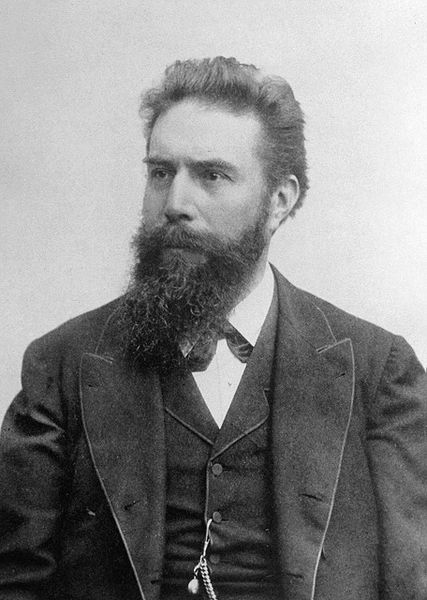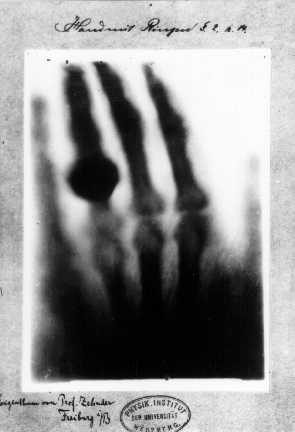<Back to Index>
- Physicist Wilhelm Conrad Röntgen, 1845
- Civil Planner Georges-Eugène Haussmann, 1809
- Prime Minister of Japan Eisaku Satō, 1901


Wilhelm Conrad Röntgen (27 March 1845 – 10 February 1923) was a German physicist, who, on 8 November 1895, produced and detected electromagnetic radiation in a wavelength range today known as x-rays or Röntgen rays, an achievement that earned him the first Nobel Prize in Physics in 1901. Following transliteration conventions for characters accented by an umlaut, "Röntgen" in English is spelled "Roentgen", and that is the usual rendering found in English-language scientific and medical references. Röntgen was born in Lennep (which is today a borough of Remscheid) in Rhenish Prussia as the only child of a merchant and manufacturer of cloth. His mother was Charlotte Constanze Frowein of Amsterdam. In March 1848, the family moved to Apeldoorn and Wilhelm was raised in the Netherlands. He received his early education at the boarding school, Institute of Martinus Herman van Doorn, in Apeldoorn. From 1861 to 1863, he attended the ambachtsschool in Utrecht.
He was expelled for refusing to reveal the identity of a classmate
guilty of drawing an unflattering portrait of one of the school's
teachers. Not only was he expelled, he subsequently found that he could
not gain admittance into any other Dutch or German gymnasium. In 1865, he tried to attend the University of Utrecht without having the necessary credentials required for a regular student. Upon hearing that he could enter the Federal Polytechnic Institute in Zurich (today known as the ETH Zurich), he passed its examinations, and began studies there as a student of mechanical engineering. In 1869, he graduated with a Ph.D. from the University of Zurich; once there, he became a favorite student of Professor August Kundt whom he followed to University of Straßburg in 1873. In 1874 Röntgen became a lecturer at University of Straßburg. In 1875 he became a professor at the Academy of Agriculture at Hohenheim, Württemberg. He returned to Straßburg as a professor of physics in 1876, and in 1879, he was appointed to the chair of physics at the University of Giessen. In 1888, he obtained the physics chair at the University of Würzburg, and in 1900 at the University of Munich, by special request of the Bavarian government. Röntgen had family in Iowa in the United States and at one time planned to emigrate. Although he accepted an appointment at Columbia University in New York City and had actually purchased transatlantic tickets, the outbreak of World War I changed his plans and he remained in Munich for the rest of his career. During 1895 Röntgen was investigating the external effects from the various types of vacuum tube equipment—apparatus from Heinrich Hertz, Johann Hittorf, William Crookes, Nikola Tesla and Philipp von Lenard—when an electrical discharge is passed through them. In early November he was repeating an experiment with one of Lenard's tubes in which a thin aluminium window
had been added to permit the cathode rays to exit the tube but a
cardboard covering was added to protect the aluminium from damage by
the strong electrostatic field that is necessary to produce the cathode
rays. He knew the cardboard covering prevented light from escaping, yet
Röntgen observed that the invisible cathode rays caused a fluorescent effect on a small cardboard screen painted with barium platinocyanide when it was placed close to the aluminium window. It occurred to Röntgen that the Hittorf-Crookes tube, which had a much thicker glass wall than the Lenard tube, might also cause this fluorescent effect. In
the late afternoon of 8 November 1895, Röntgen determined to test
his idea. He carefully constructed a black cardboard covering similar
to the one he had used on the Lenard tube. He covered the
Hittorf-Crookes tube with the cardboard and attached electrodes to a Ruhmkorff coil to generate an electrostatic charge.
Before setting up the barium platinocyanide screen to test his idea,
Röntgen darkened the room to test the opacity of his cardboard
cover. As he passed the Ruhmkorff coil charge through the tube, he
determined that the cover was light-tight and turned to prepare the
next step of the experiment. It was at this point that Röntgen
noticed a faint shimmering from a bench a meter away from the tube. To
be sure, he tried several more discharges and saw the same shimmering
each time. Striking a match, he discovered the shimmering had come from
the location of the barium platinocyanide screen he had been intending
to use next. Röntgen
speculated that a new kind of ray might be responsible. 8 November was
a Friday, so he took advantage of the weekend to repeat his experiments
and make his first notes. In the following weeks he ate and slept in
his laboratory as he investigated many properties of the new rays he
temporarily termed X-rays,
using the mathematical designation for something unknown. Although the
new rays would eventually come to bear his name in many languages where
they became known as Röntgen Rays, he always preferred the term
X-rays. Nearly two weeks after his discovery, he took the very first
picture using x-rays of his wife's hand, Anna Bertha. When she saw her
skeleton she exclaimed "I have seen my death!" At
one point while he was investigating the ability of various materials
to stop the rays, Röntgen brought a small piece of lead into
position while a discharge was occurring. Röntgen thus saw the
first radiographic image, his own flickering ghostly skeleton on the
barium platinocyanide screen. He later reported that it was at this
point that he determined to continue his experiments in secrecy,
because he feared for his professional reputation if his observations
were in error. Röntgen's original paper, "On A New Kind Of Rays" (Über eine neue Art von Strahlen), was published 50 days later on 28 December 1895. On 5 January 1896, an Austrian newspaper reported Röntgen's discovery of a new type of radiation. Röntgen was awarded an honorary Doctor of Medicine degree from the University of Würzburg after
his discovery. He published a total of 3 papers on X-rays between 1895
and 1897. Today, Röntgen is considered the father of diagnostic radiology, the medical specialty which uses imaging to diagnose disease.
Röntgen
was married to Anna Bertha Ludwig (m. 1872, d. 1919) and had one child,
Josephine Bertha Ludwig. Adopted at age 6, in 1887, she was the
daughter of Anna's brother. He died on 10 February 1923 from carcinoma of the intestine. It
is not believed his carcinoma was a result of his work with ionizing
radiation because of the brief time he spent on those investigations,
and because he was one of the few pioneers in the field who used
protective lead shields routinely. In keeping with his will, all his
personal and scientific correspondence were destroyed upon his death.
In 1901 Röntgen was awarded the very first Nobel Prize in Physics.
The award was officially "in recognition of the extraordinary services
he has rendered by the discovery of the remarkable rays subsequently
named after him". Röntgen donated the monetary reward from his
Nobel Prize to his university. Like Pierre Curie, Röntgen refused to take out patents related
to his discovery, as he wanted mankind as a whole to benefit from
its practical applications.